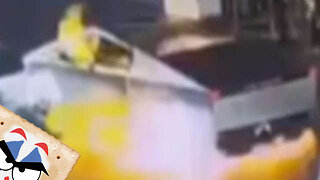Premium Only Content

Apollo 11 Saturn V Launch - Camera E-8, Slomo at 500fps ...WITH SOUND
Video of the Apollo 11 launch, taken from the base of the Launch Umbilical Tower on the Mobile Launcher. Camera E-8 captured this footage on 16 mm film at 500 frames per second. This footage takes place within approximately 30 seconds of real time.
The initial flames are the result of kerosene and liquid oxygen being released from the Saturn V rocket's fuel tanks and being ignited by hypergolic cartridges, which spin up the turbines and drive fuel to the F-1 engines. After reaching full thrust, the downward force of the exhaust creates a low pressure area which pulls the billowing gas below the vehicle and into the flame trench.
To the right of the vehicle are two tail service masts (a third is on the opposite side of the rocket), and equidistant around the rocket are four hold-down arms. At T-0, the hold down arms release the rocket, and the tail service masts begin to swing up into protective hoods.
During the launch, ice that had formed around the rocket (due to the extremely cold liquid oxygen inside) can be seen falling off. The dark material seen leaving the engines during liftoff is cooler exhaust gas from the turbines being ejected through the engine nozzle, the idea being that the cooler gas would act as an insulator for the nozzle against the extreme temperatures of the ignited fuel.
Surfaces and equipment on the Launch Umbilical Tower and Mobile Launcher were painted with an ablative material which would burn off under the heat of the launch and protect the underlying surfaces. Throughout the latter part of the video, this ablative material can be seen charring and burning.
During launch, the pad's Water Deluge System discharged some 300,000 gallons of water onto the surfaces of the Mobile Launcher and Launch Umbilical Tower, and into the flame trench, to both cool the pad and dampen the acoustic shock waves produced by the engine exhaust. During launch, much of the water boiled away as steam, though it can be seen cascading on the pad's surface in the latter part of the video.
Date 16 July 1969
Camera location 28° 36′ 29.52″ N, 80° 36′ 14.76″ W
-
 5:06
5:06
Kurt's News
1 month agoMSNBC Hacks LOSE THEIR MINDS After Elon Musk TRIGGERS Them With Memes
801 -
 2:46:06
2:46:06
DDayCobra
14 hours ago $20.09 earnedCobraCast 199
81.4K16 -
 2:07:27
2:07:27
TheSaltyCracker
13 hours agoTrump Tower Bombed w/ Cybertruck ReeEEeE Stream 01-01-25
188K423 -
 8:15:58
8:15:58
FreshandFit
20 hours agoElon Musk BETRAYAL & Mass Censorship On X
234K102 -
 2:25:43
2:25:43
Darkhorse Podcast
21 hours agoLooking Back and Looking Forward: The 258 Evolutionary Lens with Bret Weinstein and Heather Heying
219K220 -
 5:50:16
5:50:16
Pepkilla
19 hours agoRanked Warzone ~ Are we getting to platinum today or waaa
142K7 -
 9:15:09
9:15:09
BrancoFXDC
17 hours ago $9.77 earnedHAPPY NEW YEARS - Road to Platinum - Ranked Warzone
117K4 -
 5:53
5:53
SLS - Street League Skateboarding
5 days agoBraden Hoban’s San Diego Roots & Hometown Win | Kona Big Wave “Beyond The Ride” Part 2
119K14 -
 6:03:57
6:03:57
TheBedBug
22 hours ago🔴 LIVE: EPIC CROSSOVER - PATH OF EXILE 2 x MARVEL RIVALS
114K9 -
 1:12:45
1:12:45
The Quartering
20 hours agoTerror In New Orleans, Attacker Unmasked, Tesla BLOWS UP At Trump Tower! Are We Under Attack?
178K293